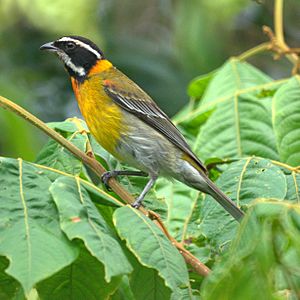Puerto Rican spindalis facts for kids
Quick facts for kids Puerto Rican spindalis |
|
|---|---|
 |
|
| Male | |
| Conservation status | |
| Scientific classification | |
| Genus: |
Spindalis
|
| Species: |
portoricensis
|
| Synonyms | |
|
Spindalis zena portoricensis |
|
The Puerto Rican spindalis (Spindalis portoricensis) is a beautiful bird found only on the island of Puerto Rico. People there often call it reina mora, which means "moorish queen." This bird is very important to Puerto Rico's ecosystem. It helps spread seeds and helps plants reproduce. Some people even think it should be the national bird of Puerto Rico!
Contents
Understanding the Puerto Rican Spindalis
How Scientists Classify Birds
The Puerto Rican spindalis was once thought to be a type of western spindalis. It was called Spindalis zena portoricensis, meaning it was a subspecies. A subspecies is like a special group within a species.
But in 1997, scientists studied the Spindalis bird family very closely. They looked at things like weight, color, patterns, where the birds lived, and their voices.
They decided that the Puerto Rican spindalis was different enough to be its own unique species. So, it became Spindalis portoricensis. This means it's not just a type of western spindalis anymore.
What Makes This Bird Special?
Scientists found four different species in the Spindalis group. These included the Puerto Rican spindalis. The way the Puerto Rican spindalis sings and its body shape helped show it was unique.
Appearance of the Puerto Rican Spindalis
Male vs. Female Birds
Puerto Rican spindalis birds show something called sexual dimorphism. This means males and females look different.
Male birds are very colorful. They have green backs and bright orange necks and chests. Their heads are black with two white stripes. One stripe is above their eyes, and one is below. Their tails and wings are gray or black with small white tips.
Female birds are much duller. They are mostly an olive-green color. Their white stripes are also harder to see.
Size and Weight Differences
Males and females also differ slightly in size and weight. Females are usually a bit heavier than males. However, males are slightly longer.
- Male weight: 22.5 to 37.0 grams (average 30.8 grams)
- Female weight: 28.0 to 41.1 grams (average 33.5 grams)
- Male wing length: 82 to 88.5 millimeters (average 85.2 mm)
- Female wing length: 80 to 85.5 millimeters (average 82.6 mm)
- Male tail length: 59 to 68 millimeters (average 63.3 mm)
- Female tail length: 56 to 65.5 millimeters (average 60.6 mm)
Where the Spindalis Lives
The Puerto Rican spindalis is often found in plantations. These are places where crops are grown. They also live in natural forests, like the Maricao State Forest and the El Yunque National Forest.
You might also spot them in gardens. They look for flower nectar there. They also like areas where fruits grow. You can even attract them to your yard with a bird feeder filled with a sugar solution!
These birds live all over the main island of Puerto Rico. They are rarely found high up in the mountains, usually staying below 1000 meters in elevation.
Behavior of the Puerto Rican Spindalis
Social Life and Mobbing
Puerto Rican spindalis birds usually travel in pairs. Sometimes, they form small groups.
They also do something called mobbing. This is when a group of birds, sometimes from different species, attacks a predator. They do this to protect their eggs or young birds. Young spindalis birds have been seen mobbing the Puerto Rican boa, which is a type of snake.
Bird Calls and Songs
The songs of the Puerto Rican spindalis are not as fancy as some other Spindalis species. Only the S. dominicensis has simpler calls.
Male spindalis birds make high-pitched sounds. These sounds are usually 8 kHz (kilohertz) or higher. They often sing from the tops of tall trees.
Female birds sing "whisper songs." They usually do this from thick bushes close to the ground.
The most common call sounds like a "continuing series of high-pitched, thin, sibilant notes, given in a rhythmic pattern." Other calls include a quick tweet and a short chi chi chi.
Diet of the Spindalis
The Puerto Rican spindalis mainly eats fruit. They enjoy fruit from trees like Schefflera morototoni, Cecropia schreberiana, Cordia sulcata, Ficus species, Phoradendron species, and Inga vera. Fruit from S. morototoni is especially important to them.
Fruits and leaves don't give a lot of energy. So, these birds also eat insects and small lizards. This helps them get enough energy.
Reproduction and Life Cycle
The Puerto Rican spindalis builds cup-shaped nests. They make these nests from different plant materials.
Females usually lay two to four eggs at a time. The eggs are typically light blue. They have brown spots around the larger end. However, the exact look of the eggs can be different depending on the region. On average, the eggs are about 23.7 by 17.3 millimeters in size.
See also
 In Spanish: Cigua puertorriqueña para niños
In Spanish: Cigua puertorriqueña para niños



